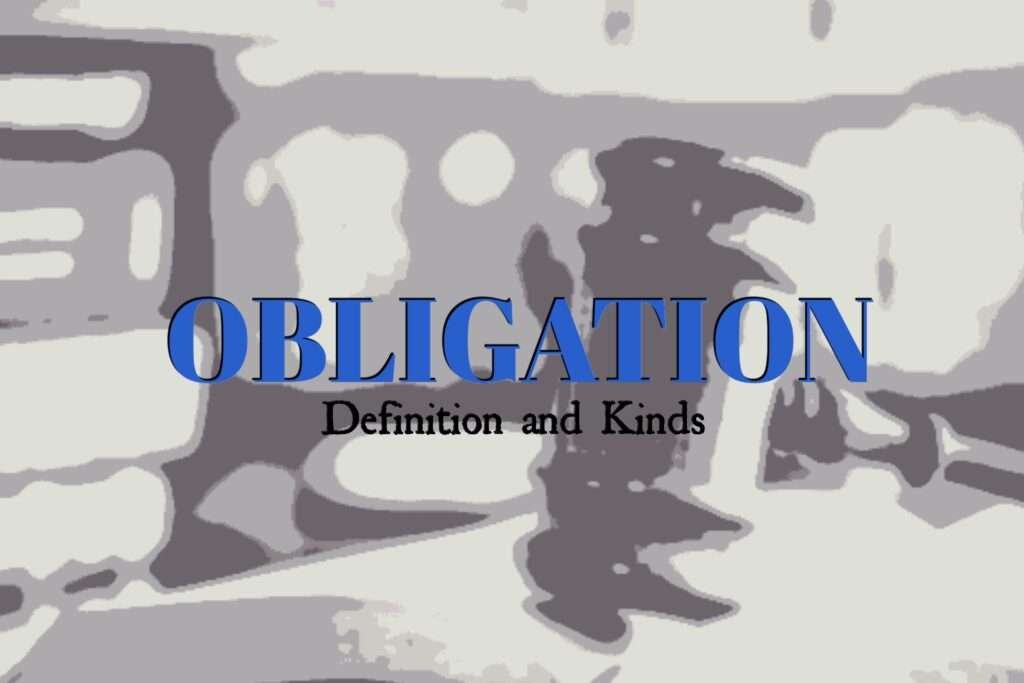
According to Holland, An obligation as its entomology denotes is a tie by one person is bound to perform some act for the benefit of another. In some cases, the two parties agree thus to be bound together; in other cases as they are bound without their consent.
Definition of obligation –
Although It is hard to define term Obligation some eminent Jurists defined obligation. Definitions of Obligation are as follows –
- Salmond – According to Sir John Salmond” An obligation, therefore, may be defined as a proprietary right in personam or a duty which corresponds to such a right.” Obligations are all in one class of duties, namely those which are co-relatives of rights in personam.
- Savigny – According to Savigny an obligation is the control over another person, yet not over his person in all respects (in which case his personality would be destroyed), but over single acts of his which must be conceived of subtracted from his free will and subjected to our will
- Paton – According to Prof. Paton, an obligation is that part of law which creates right in personam
- Anson – According to Anson, “an obligation is a control exercisable by definite persons over definite persons for the purpose of Definite acts or forbearance reducible to a money value“
Kinds of obligations –
- Sole Obligation – Sole obligation is one in which there is one creditor and one debtor. e.g. A promise to B to pay $100. In this example, there is only one creditor and one debtor.
- Solidary Obligation – In case of Solidary Obligation there are two or more debtors owe the same thing to the same creditor. There are three kinds of solidary obligation see kinds of solidary obligation.
Meaning of Solidary Obligation –
In most cases, the obligation is between two people, but solidary obligation refers to obligations that involve more than two people. On one hand, there may be two or more parties, and on the other hand, there may be two or more parties. When two or more people owe their obligations to The same person, this is an example of solidary obligation.
In this case, the person with the right can appoint any of the several people entrusted with the duty to carry out the task. In other words, if you have a creditor on one hand and several debtors on the other, all of whom owe the same debt to the same creditor, the creditor can ask any of the debtors to pay the debt.
Kinds of solidary obligations –
In English law, solitary obligations are three distinct kinds which are- several obligation, joint obligations and joint and several obligations.
- Several solidary obligations – Solidary obligations are several when, Although the thing owed in the same in each case, there are as many distinct obligations and causes of action as there are debtors.
- Joint solidary obligation – Solidary obligations are joint when though there are two or more debtors, there is only one debt or other cause of action, as well as only one thing owed. The creditor must sue all of them and release of one operates as a release of others. For example when a Firm contracts a Debt all the partners are jointly liable. In English law, the liability of joint debtors is joint while in India it is joint and several
- Joint and several solidary obligations – Certain solidary obligations are both joint and several. These obligations stand Midway between the above two. In this the creditor can sue one, some or all of them and release of one will not operate as a release of all other feasors. for example liability of joint tort committing the Tort jointly or two or more trustees jointly committing the same breach of Trust or joint debtors under Indian law.
Sources of Obligations
- Contractual obligation (obligations ex contractu)
According to Section 2(h) of the Indian Contracts Act, Contracts are legally binding agreements. These are the obligations that result from a contract between two people. It establishes in personam rights between the parties. The rights that are created in this way are usually proprietary rights. Sometimes, despite being in personam, a contract creates rights that are not proprietary.
It establishes a right in personam between the parties, but there are some exceptions, such as a promise of marriage that falls under the law of status. In a contract, one party agrees to do or refrain from doing something in exchange for the other’s promise. As a result, we can assume that they have obligations to fulfill rights and duties on both sides of the contract. In a contract, both the promisor and the promise perform their duties and have rights against each other, resulting in mutuality of obligations.
- Delictual obligation (Obligationes ex delicto)
These are the obligations that arise as a result of torts. As Salmond says “A Tort may be defined as a civil wrong for which the remedy is a damages action and which is not solely a breach of contract, breach of trust, or other merely equitable obligations,”
Delictual obligations are those in which a sum of money is due as compensation for a wrongdoing.
- Damages in torts are unliquidated (i.e., the amount of compensation is not predetermined), whereas
- Damages in contracts are inherently liquidated.
Tortious liability arises from the breach of a duty owed to another person. “Tortious liability arises from the breach of a duty primarily fixed by law; this duty is towards persons generally, and its breach is repressible by an action for unliquidated damages,” according to Dr. Winfield.
It means that delictual obligations are the duty to make monetary restoration for the wrong, i.e. the defendant’s tort. Individuals are allowed to comply with such a duty established by law, and if they do not comply with their duty and cause harm to others, the person against whom tort is committed has the right to claim unliquidated damages from the one who did not comply with such duty.
- Quasi-contract obligation (Obligationes quasi-ex-contractu)
These are the obligations created by quasi-contracts.
“Quasi” = Latin word = means “as if” or “in a similar way.”
A quasi-contract is one in which the parties do not intend to enter into a real contract. It is similar to a contract, in which the law requires a person to perform an obligation on the basis of equity. The principle of equity states that “a person shall not be allowed to enrich himself unjustly at the expense of another.” Quasi-contract is based on this principle. To put it another way, no one should receive or accept any benefit unfairly. If that’s the case, he owes it to the rightful owner. Quasi-contractual obligations are such obligations.
For example, “X” accidentally leaves his bag at Y’s house. “Y” is obligated to return it to “X” under the terms of a quasi-contract.
These obligations are regarded as contractual by law, despite the fact that they are not. Such obligations were originally known as
- obligationes quasi ex contractu in Roman law,
- quasi-contractual in English law.
Quasi contracts are those that are formed through the intervention of the courts rather than through a formal agreement and the consent of the parties.
Under Chapter V of the Indian Contract Act, 1872, quasi-contractual obligations are very precisely defined with examples. A parent’s responsibility to their child is a well-defined example of quasi-contracts. Another example is a relationship built on trust.
- Innominate obligation
“Innominate obligation is a type of residuary obligation” according to Salmond,
Innominate obligations are not purely Non-contractual, delictual, and quasi-contractual obligations . This means they haven’t been given a name or a label.
For example. With regard to the beneficiary, the trustee has a fiduciary obligation. Infringement of a trustee’s obligation on a beneficiary’s property is directly responsible to the trustee.
Elements of Obligation
- The ACTIVE SUBJECT is the person who has the authority to demand that the obligation be performed or paid. He is also known as the creditor or the obligee.
- The PASSIVE SUBJECT is the person who is obligated to perform or pay something. He is the one who can be held responsible for the debt. He’s also known as the obligor or debtor.
- The contract’s object is the PRESTATION. It is the behaviour that the debtor or obligor is expected to follow. It could be a legal obligation to give, do, or not do something.
- The legal or juridical tie is also known as the VINCULUM JURIS. Others refer to it as the efficient cause. It is what binds or connects the parties to the agreement. (De Leon) To put it another way, it’s the legal relationship that exists between the debtor and the creditor (or obligor and obligee).
Example: Under a contract of sale, D agreed to deliver a book to C for Rs 1000.
- C is the active subject
- D is the passive subject
- The delivery of the book is the prestation
- The contract of sale is the juridical tie that binds X and Y.




0 Comments